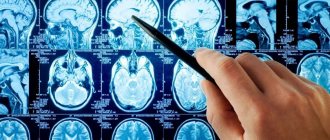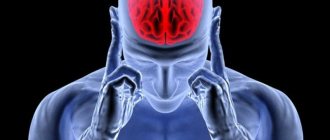What are the features of the symptoms of this disease?
In the presence of an ischemic stroke in the territory of the right middle cerebral artery, it is possible to identify symptoms of lesions of the midbrain and cerebral hemisphere, depending on the location and conditions of collateral blood supply in the clinical pictures. Quite often you can find a combination of damage to the thalamus and the cerebral hemisphere or isolated infarctions of the thalamus. It should be noted that in most cases, the symptoms of the disease in patients can be combined. The most common symptoms include visual damage, neuropsychological damage, and hemiparesis.
Prognosis and prevention of cardioembolic stroke in atrial fibrillation
V.A. PARFENOV
, Doctor of Medical Sciences, Professor,
S.V.
VERBITSKAYA ,
First Moscow State Medical University named after. THEM. Sechenov A review of the literature on the prediction and prevention of stroke in atrial fibrillation (AF) is presented.
It is noted that the easy-to-use CHA2DS2-VASc scale can well predict the risk of stroke in AF. In patients with one or more risk factors for stroke according to the CHA2DS2-VASc scale, the use of oral anticoagulants is recommended. Data from large randomized trials are presented that show that new oral anticoagulants (dabigatran, rivaroxaban, apixaban) are not inferior to warfarin or have the advantage of a more significant reduction in the risk of stroke and a less significant risk of major, especially intracranial, bleeding. There has been positive practical experience with the use of dabigatran (Pradaxa®) at a dose of 150 mg or 110 mg twice in patients with AF. In our country, the introduction into neurological practice of new anticoagulants, the use of which does not require control using the international normalizing ratio, will make it possible to more widely prescribe anticoagulant therapy to patients with AF and reduce the incidence of cardioembolic stroke. Atrial fibrillation (AF, atrial fibrillation) is one of the most common heart rhythm disorders; its frequency increases with age; in people over 70 years of age, AF occurs in approximately 5% of cases [1, 2]. Persistent and paroxysmal form of non-valvular AF is one of the most important risk factors for ischemic stroke (IS), increasing the likelihood of its development by 3–4 times [1]. In patients with AF, a slowdown in blood flow occurs, leading to the formation of blood clots mainly in the left atrial appendage, which can cause embolism in the blood vessels of the brain and other organs.
Predicting the risk of stroke in atrial fibrillation
In patients with AF, the risk of stroke increases with increasing age, in the presence of heart failure, arterial hypertension, diabetes mellitus, previous episodes of thromboembolism, mitral valve calcification, or thrombus in the left atrium [2].
In clinical practice, the CHADS2 scale has been used for a long time as the main scale to predict and assess the risk of thromboembolic complications in patients with AF, among whom AI is of leading importance. The abbreviation CHADS2 comes from the first letters of the English names of individual risk factors for stroke: Congestive heart failure - chronic heart failure, Hypertension - arterial hypertension, Age - age over 75 years, Diabetes mellitus - diabetes mellitus, Stroke - AI or transient ischemic attack (TIA) in medical history. In this scale, 2 points are assigned to stroke or TIA (therefore, an index of 2 is assigned next to the letter “S”) and 1 point to other factors (Table 1). The higher the CHADS2 score, the higher the risk of stroke, and vice versa (Table 2).
In recent years, the CHA2DS2-VASc scale [3], which is an extension of the CHADS2 scale to which other independent risk factors for IS have been added, has been proposed and widely introduced into clinical practice (Table 3).
In this scale (in addition to the CHADS2 scale), the following vascular risk factors are used: vascular damage (history of myocardial infarction, peripheral arterial atherosclerosis, aortic atherosclerosis), age 65–74 years, female gender.
If the maximum number of points on the CHADS2 scale is 6, then on the CHA2DS2-VASc scale it is 9. In 2010, the CHA2DS2-VASc scale was included in the recommendations of the European Society of Cardiology [4] for assessing the risk of IS in AF.
The CHA2DS2-VASc scale includes more factors that determine the risk of stroke, its superiority over the CHADS2 scale has been confirmed in several clinical studies, among which a recent large study that included data on 73,538 patients with AF who did not receive anticoagulant therapy is particularly noteworthy [5]. During a year of observation in individuals with “low risk” (score = 0), the frequency of systemic thromboembolic complications according to the CHADS2 scale was 1.67 per hundred patients per year, and according to the CHA2DS2-VASc scale – 0.78. The data obtained demonstrate that patients who were classified as low risk according to the CHA2DS2VASc scale had a truly low risk of developing thromboembolic complications. Analysis of the results of observation of this large group of patients over 10 years shows a significantly higher information content of the CHA2DS2-VASc scale in comparison with the CHADS2 scale. Many patients from the so-called. low-risk groups according to the CHADS2 scale have a fairly high risk of thromboembolic complications. Overall, the CHA2DS2-VASc score is better at predicting stroke risk (Table 4) than the CHADS2 score.
Prevention of cardioembolic stroke
To prevent stroke and other thromboembolic complications (systemic embolism) in AF, until recently, the use of aspirin or indirect anticoagulants (warfarin) under the control of the international normalized ratio (INR) was recommended [6–9]. For patients with AF under 75 years of age who have no history of stroke and are at low risk of developing it (less than 2% per year), aspirin is recommended at a dose of 75–325 mg per day. With a higher risk of stroke in patients with AF (4% per year or more), the prescription of warfarin (with a target INR of 2–3) was considered justified in the absence of contraindications to its use [6, 7].
A meta-analysis of several studies showed that the use of warfarin in AF reduces the risk of stroke by an average of 68% [10]. During the year, treatment with warfarin in 1 thousand patients with AF prevents the development of 31 IS. Major bleeding occurs relatively rarely in 1.3% of cases (in the placebo or aspirin group in 1% of cases) if the INR is maintained in the therapeutic range of 2 to 3. When treating with warfarin, it is necessary to remember its possible interaction with other drugs and foods, the need for regular laboratory monitoring of INR and, on this basis, dose adjustment of the drug. The effectiveness of aspirin in AF is much lower; it reduces the risk of stroke by an average of 21% in patients with AF.
The widespread use of warfarin in our country is limited to a certain extent by the fact that many patients who have undergone IS due to AF refuse treatment with the drug due to the need to regularly visit the clinic to monitor the INR and limit the intake of certain foods and drugs. During follow-up (an average of more than 4 years) of 77 patients who underwent IS due to AF, only 21 patients (27.2%) began to regularly take warfarin and achieved an INR of 2 to 3 [11].
In arterial hypertension, its effective treatment with normalization of blood pressure (BP) reduces the risk of both stroke and bleeding when taking anticoagulants or antiplatelet agents [5]. In approximately one third of patients who have suffered an IS or TIA due to AF, another possible cause of IS is found, for example, significant stenosis of the internal carotid artery. In such cases, combination therapy is possible, for example, carotid endarterectomy and subsequent treatment with anticoagulants.
When treating with antithrombotic drugs, it is necessary to take into account the risk of bleeding, especially intracranial bleeding, which often leads to the death of the patient. The risk of bleeding should be assessed before prescribing anticoagulant therapy in patients with AF. In clinical practice, the HAS-BLED scale is used to assess the risk of bleeding [12], which is included in modern recommendations for the treatment of AF (Table 5).
Currently, the effectiveness of new oral anticoagulants that affect other stages of blood coagulation (Fig. 1) and do not require constant monitoring of the INR, as with warfarin treatment, is being actively studied in patients suffering from AF.
The results of several large randomized trials have shown that new indirect anticoagulants are not inferior to warfarin or even superior to it in preventing stroke, while being characterized by a lower risk of bleeding, especially intracranial. The first of this group of drugs to prove its effectiveness was dabigatran etexilate (dabigatran), which is currently widely used throughout the world for the prevention of stroke in AF.
Dabigatran in stroke prevention
Dabigatran is a direct thrombin inhibitor, the effectiveness and safety of which in the prevention of stroke and thromboembolic complications in patients with AF compared with warfarin was studied in the RE-LY study [13]. The study included patients with AF who had at least one or more risk factors for stroke and systemic embolism: history of stroke or TIA, left ventricular ejection fraction less than 40%, heart failure NYHA class 2 or higher (within 6 months . and more), age 75 years and older, or age 65 years and older in combination with arterial hypertension, diabetes mellitus or coronary heart disease. Exclusion criteria for participation in the study were: severe heart valve pathology, the presence of a prosthetic heart valve, ischemic stroke within 14 days before inclusion in the study, severe stroke within 6 months. before inclusion in the study, severe disability due to stroke, high risk of bleeding, creatinine clearance less than 30 ml/min, active liver disease, pregnancy.
The primary objective of the study was to compare the incidence of stroke and systemic embolism while taking dabigatran at a dose of 110 or 150 mg twice daily or warfarin at a dose that maintains an INR of 2 to 3. The primary safety endpoint was the incidence of major bleeding at various treatment regimens according to the frequency of life-threatening hemorrhages. The study included 18,113 patients at 967 centers in 44 countries. The study design involved randomization of patients into three groups: two groups received the study drug dabigatran etexilate at a dose of 150 mg or 110 mg twice a day, in the third group patients received the comparison drug warfarin. The groups were homogeneous in size and did not differ from each other in basic clinical characteristics, some of which are shown in Table 6.
During an average of two years of follow-up, major vascular events (stroke, systemic embolism) developed significantly less frequently in the group of patients taking dabigatran 150 mg twice daily (1.11% per year) than in the group of patients receiving warfarin (1. 71% per year). In the group of patients receiving dabigatran 110 mg twice daily, the rate of stroke and embolic events was 1.54% per year, which was comparable to the rate of events in the warfarin group. Mortality (from all causes) at one year was 4.13% in the warfarin group and trended lower in the dabigatran 110 mg group (3.75%) and in the dabigatran 150 mg group (3.64%). Mortality from cardiovascular diseases during the year was 2.69% in the warfarin group, it tended to decrease (2.43%) in the dabigatran 110 mg group and was significantly lower (2.28%) in the dabigatran 150 mg group. The incidence of major bleeding during the year during warfarin therapy was 3.36%, tended to decrease in the dabigatran 150 mg group (3.11%) and was significantly lower (2.71%) in the dabigatran 110 mg group. The incidence of life-threatening bleeding within a year was 1.24% in the group of patients taking dabigatran 110 mg twice a day, 1.49% in the group receiving dabigatran 150 mg twice a day, and was significantly higher (1.85% ) in the warfarin group. The incidence of hemorrhagic stroke within a year was 0.12% in the dabigatran 110 mg group, 0.10% in the dabigatran 150 mg group and was significantly higher (0.38%) during warfarin therapy.
The main adverse events during the entire treatment period are presented in Table 7, which shows that there were no significant differences between the groups in the main adverse events, with the exception of dyspepsia, which was slightly higher in the group of patients taking dabigatran.
Among the patients participating in the study, almost every fifth suffered a stroke or TIA; using randomization, these patients, along with the rest, were divided into three main groups; Thus, 1,195 patients took dabigatran 110 mg twice a day, 1,233 took dabigatran 150 mg twice a day, 1,195 patients took warfarin. In the subgroup of patients with a history of stroke or TIA, the incidence of stroke and systemic embolism per year was 2.38%, which was significantly more common than in patients without a history of stroke or TIA - 1.22%. Analysis of the study results in this subgroup of patients showed that the main patterns observed in the entire group of patients are preserved; There was no effect of previous stroke or TIA on the main differences noted between the groups of patients receiving dabigatran or warfarin therapy [15]. In patients with a history of stroke or TIA, there was a trend towards a lower incidence of major events (stroke, systemic embolism) with dabigatran compared with warfarin, with a significantly lower incidence of events with dabigatran 150 mg twice daily (Table 1). 8).
In patients who had a stroke or TIA, there was a significant reduction in the incidence of hemorrhagic stroke when taking dabigatran compared with treatment with warfarin, with the greatest benefit in reducing the incidence of hemorrhagic stroke observed in the dabigatran 110 mg twice daily group (Table 9). The incidence of intracranial hemorrhage was also higher in the subgroup of patients taking warfarin. The incidence of all strokes tended to be higher in the subgroup of patients receiving warfarin, due to a higher incidence of hemorrhagic stroke.
In a subgroup of patients who had a stroke or TIA, treatment with dabigatran 110 mg twice daily was associated with a reduction in the incidence of death from cardiovascular causes, as well as a reduction in the incidence of life-threatening bleeding compared with warfarin. The incidence of gastrointestinal bleeding was comparable in the subgroups of patients taking dabigatran 110 mg twice daily or warfarin. In patients receiving dabigatran therapy at a dose of 150 mg 2 times a day, gastrointestinal bleeding occurred more often than in the warfarin group. The incidence of myocardial infarction did not differ significantly between patients with stroke or TIA based on therapeutic regimens.
Rivaroxaban in stroke prevention
Rivaroxaban (a direct factor Xa inhibitor) at a dose of 20 mg or 15 mg (in patients with creatinine clearance 30–50 ml/min) per day was studied in patients with non-valvular AF compared with warfarin in the ROCKET AF trial [14]. The study included AF patients with moderate and high risk of stroke; more than half of the patients suffered a TIA or stroke or an episode of systemic embolism. The study included 14,264 patients (60% men, 40% women, mean age 73 years), with a mean follow-up of 707 days. The primary endpoint of the study was the incidence of major vascular events (IS, hemorrhagic stroke, systemic embolism) in patients taking rivaroxaban or warfarin. The safety of treatment was assessed by the incidence of clinically significant hemorrhagic events.
The study found that major vascular events occurred at a rate of 1.7% per year in patients receiving rivaroxaban and 2.2% per year in patients receiving warfarin (p < 0.001). Clinically significant hemorrhage occurred at an incidence of 14.9% per year in patients taking rivaroxaban and 14.5% per year in patients taking warfarin (p = 0.44). In the group of patients taking rivaroxaban, intracranial hemorrhages (0.5%; in the warfarin group - 0.7%, p = 0.02) and fatal hemorrhages (0.2%; in the warfarin group - 0.5) were less likely to develop. %, p = 0.003).
In the subgroup of patients who did not have a history of TIA, IS, or episodes of systemic embolism, the incidence of major events was 2.57% when taking rivaroxaban and 3.61% in the warfarin group, which proves the superiority of rivaroxaban over warfarin in the primary prevention of IS, TIA and systemic embolism. In this subgroup, clinically significant hemorrhages occurred less frequently (1.67%) with rivaroxaban than with warfarin (2.86%).
In the subgroup of patients with a history of IS, TIA, or an episode of systemic embolism, the incidence of major events was not significantly different and reached 4.8% and 4.9%, respectively, when using rivaroxaban and warfarin, respectively. In this subgroup, clinically significant hemorrhages occurred at a rate of 3.5% with rivaroxaban and 3.9% with warfarin.
Apixaban in stroke prevention
Apixaban (a direct factor Xa inhibitor) was studied for the prevention of thromboembolic events in patients with non-valvular AF in the AVERROES [15] and ARISTOTLE [16] studies.
The AVERROES trial [15] examined the effectiveness of apixaban and aspirin in 5,599 patients (mean age 70 years, 41% women and 59% men) with non-valvular AF and one or more additional risk factors for stroke (median CHADS2 score of 2 points). , for whom it was impossible to prescribe warfarin therapy for a number of reasons. Apixaban was used at a dose of 5 mg twice daily (in 94% of cases) or 2.5 mg twice daily (in 6% of cases in patients who met 2 or more of the following criteria: age 80 years or older, weight 60 kg or less, creatinine level 133 mmol/l or more). Aspirin was used at a dose of 81–324 mg per day.
The study was stopped early because there was strong evidence of superiority of apixaban over aspirin. The incidence of stroke or systemic embolism in the apixaban group was 1.6% per year, which was significantly lower than in the aspirin group, in which it reached 3.7% per year. Apixaban was significantly more effective than aspirin in preventing severe and fatal stroke, the incidence of which was 1% in the apixaban group and 2.3% per year in the aspirin group. The incidence of clinically significant bleeding did not differ significantly between treatment groups and was 1.4% per year in the apixaban group and 1.2% per year in the aspirin group.
In a small group of patients who had an IS or TIA, the incidence of recurrent IS or systemic embolism was 2.5% in patients in the apixaban group and significantly higher - 8.3% - in the aspirin group. However, the incidence of clinically significant bleeding did not differ significantly and was 3.5% per year in the apixaban group and 2.7% per year in the aspirin group.
The ARISTOTLE trial [16] compared the effectiveness of apixaban and warfarin in preventing stroke or systemic embolism in 18,201 patients (mean age 70 years, 35% women, 65% men) with AF who had at least one additional risk factor for stroke. Apixaban was used in dosages of 5 mg or 2.5 mg (in patients with creatinine clearance 30-50 ml/min) 2 times a day, warfarin - in doses necessary to achieve an INR of 2.0-3.0. The average follow-up time for patients was approximately 2 years.
The incidence of stroke or systemic embolism was 1.27% in the apixaban group, which was significantly lower than in the warfarin group - 1.6%. In the apixaban group, the incidence of hemorrhagic stroke was significantly reduced (by 49%) and, to a lesser extent (8%), the incidence of IS or unspecified stroke. The incidence of deaths in the apixaban group was 3.52% per year, in the warfarin group it was significantly higher - 3.94% (p = 0.047). The incidence of serious bleeding was 2.13% in the apixaban group and was significantly higher – 3.09% – in the warfarin group (p < 0.001). The advantage of apixaban over warfarin was also noted in the group of patients who had a TIA or IS. Modern approach to stroke prevention
Based on the results of recent studies, recommendations have been made [4] for the prevention of stroke and other thromboembolic complications in patients with AF using the CHA2DS2-VASc scale (Table 10).
As can be seen from the data presented in the table, oral anticoagulants are recommended as treatment for patients with one or more points on the CHA2DS2-VASc scale.
Among the new oral anticoagulants, dabigatran (Pradaxa) is currently the most widely used. When treated with dabigatran - unlike warfarin - there is no need to select the dose of the drug, regular laboratory (hematological) monitoring, restriction of intake of many foods and drugs, which improves the quality of life of patients with AF [16]. Dabigatran is prescribed in a fixed dose of 150 mg or 110 mg twice daily. If laboratory (hematological) monitoring of dabigatran is necessary, partially activated thromboplastin time, thrombin time and other coagulogram indicators can be used [17].
When choosing a dose of dabigatran (110 mg or 150 mg twice daily), one should in each case take into account the possible risk of developing IS, systemic embolism and bleeding. Dabigatran at a dose of 150 mg twice a day has an advantage in the prevention of the development of IS and systemic embolism compared with warfarin; at a dose of 110 mg twice a day it is characterized by a lower incidence of bleeding of various locations, including intracranial. In most cases of AF, more reliable prevention of stroke and systemic embolism is necessary, so dabigatran 150 mg twice daily is preferable. However, in some patients at high risk of bleeding, it is advisable to use a dose of 110 mg twice daily. Currently, only a high dose (150 mg twice daily) of dabigatran is recommended for stroke prevention in AF in the United States [18]. A quantitative analysis of all possible advantages and disadvantages of different doses of dabigatran demonstrates the advantage of a large dose [19].
One question that was not answered by the RE-LY study concerns the timing of dabigatran administration in patients with AF who have had an IS or TIA. Is it possible to prescribe dabigatran in the earliest period after the development of IS or TIA, which is advisable in most cases? The RE-LY study enrolled patients who had suffered a stroke or TIA only after 2 weeks. from the moment of illness, so the question of prescribing dabigatran for up to 2 weeks. after IS and TIA remains controversial and requires further research in this direction.
The advantage of treatment with dabigatran and other new oral anticoagulants over warfarin is of particular importance in cases where patients live in regions where laboratory monitoring of INR during warfarin treatment is poorly established [20, 21]. Unfortunately, in our country, neurologists, when caring for patients who have suffered an IS or TIA due to AF, often face significant problems due to the lack of an established laboratory service necessary to monitor the INR when prescribing warfarin therapy [22]. Therefore, the use of new oral anticoagulants, the treatment of which does not require dose selection or regular laboratory monitoring, will allow neurologists to more effectively carry out secondary prevention of cardioembolic stroke in patients with non-valvular AF.
It has now been proven that the use of the easy-to-use CHA2DS2-VASc stroke risk scale allows predicting the likelihood of thromboembolic events in patients with AF. In patients with one or more risk factors for stroke according to the CHA2DS2-VASc scale, it is recommended to use warfarin or newer oral anticoagulants (dabigatran, rivaroxaban, apixaban). Currently, positive global practical experience has been accumulated in the use of dabigatran in doses of 110 mg or 150 mg twice a day to prevent stroke, systemic embolism and reduce cardiovascular mortality. In our country, a significant proportion of patients who have suffered ischemic stroke or TIA due to AF do not take warfarin due to the difficulty of regular INR monitoring. The introduction of new anticoagulants into neurological practice, the administration of which does not require INR control, will make it possible to more widely prescribe anticoagulant therapy to patients with AF and reduce the incidence of cardioembolic stroke.
Literature
1. Wolf PA, Abbott RD, Kannel WB. Atrial fibrillation as an independent risk factor for stroke: the Framingham Study. Stroke 1991;22:983-988. 2. Stroke in Atrial Fibrillation Working Group. Independent predictors of stroke in atrial fibrillation: a systematic review. Neurology 2007;69:546-554. 3. Lip GY, Nieuwlaat R, Pisters R, Lane DA, Crijns HJ. Refining clinical risk stratification for predicting stroke and thromboembolism in atrial fibrillation using a novel risk factor-based approach: the euro heart survey on atrial fibrillation. Chest 2010;137:263-272. 4. European Heart Rhythm Association; European Association for Cardio-Thoracic Surgery, Camm AJ, Kirchhof P, Lip GY et al. Guidelines for the management of atrial fibrillation: the Task Force for the Management of Atrial Fibrillation of the European Society of Cardiology (ESC). Eur Heart J 2010;31:2369-2429. 5. Olesen JB, Lip GY, Hansen ML et al. Validation of risk stratification schemes for predicting stroke and thromboembolism in patients with atrial fibrillation: national cohort study. BMJ 2011;342:d124. 6. Sacco RL, Adams R, Albers G et al. Guidelines for Prevention of Stroke in Patients With Ischemic Stroke or Transient Ischemic Attack: A Statement for Healthcare Professionals From the American Heart Association/American Stroke Association Council on Stroke: Co-Sponsored by the Council on Cardiovascular Radiology and Intervention: The American Academy of Neurology affirms the value of this guideline. Stroke 2006;37:577-617. 7. European Stroke Organization (ESO) Executive Committee; ESO Writing Committee. Guidelines for management of ischemic stroke and transient ischemic attack. Cerebrovasc Dis. 2008;25:457-507. 8. Suslina Z.A., Fonyakin A.V., Geraskina L.A. and others. Practical cardioneurology. M., IMA-PRESS, 2010. – 304 p. 9. Furie KL, Kasner SE, Adams RJ et al. Guidelines for the Prevention of Stroke in Patients With Stroke or Transient Ischemic Attack A Guideline for Healthcare Professionals From the American Heart Association/American Stroke Association. Stroke 2011;42:227-276. 10. Risk factors for stroke and efficacy of antithrombotic therapy in atrial fibrillation: analysis of pooled data from five randomized controlled trials. Arch Intern Med 1994;154:1449-1457. 11. Verbitskaya S.V., Parfenov V.A. Secondary prevention of stroke in outpatient settings. Neurological Journal 2011;1:17-21. 12. Pisters R, Lane DA, Nieuwlaat R et al. .A novel user-friendly score (HAS-BLED) to assess 1-year risk of major bleeding in patients with atrial fibrillation: the Euro Heart Survey. Chest 2010;138:1093-1100. 13. Connolly SJ, Ezekowitz MD, Yusuf S et al. Dabigatran versus warfarin in patients with atrial fibrillation. N Engl J Med 2009;361:1139-1151. 14. Patel MR, Mahaffey KW, Garg J et al. Rivaroxaban versus warfarin in nonvalvular atrial fibrillation. N Engl J Med 2011;365:883-891. 15. Connolly SJ, Eikelboom J, Joyner C et al. Apixaban in patients with atrial fibrillation. N Engl J Med 2011;364:806-817. 16. Granger CB, Alexander JH, McMurray JJ et al. Apixaban versus warfarin in patients with atrial fibrillation. N Engl J Med 2011;365:981-992. 17. Van Ryn J, Stangier J, Haertter S et al. Dabigatran etexilate—a novel, reversible, oral direct thrombin inhibitor: interpretation of coagulation assays and reversal of anticoagulant activity. Thromb Haemost 2010;103:1116-1127. 18. Beasley BN, Unger EF, Temple R. Anticoagulant options—why the FDA approved a higher but not a lower dose of dabigatran. N Engl J Med 2011;364:1788-1790. 19. Pink J, Lane S, Pirmohamed M, Hughes DA. Dabigatran etexilate versus warfarin in the management of non-valvular atrial fibrillation in the UK context: quantitative benefit-harm and economic analyses. BMJ 2011;343:d6333. doi: 10.1136/bmj.d6333. 20. Kamel H, Johnston SC, Easton JD, Kim AS. Cost-Effectiveness of Dabigatran Compared With Warfarin for Stroke Prevention in Patients With Atrial Fibrillation and Prior Stroke or Transient Ischemic Attack. Stroke 2012;43:881-883. 21. Harris K, Mant J. Potential impact of new oral anticoagulants on the management of atrial fibrillation-related stroke in primary care. Int J Clin Pract. 2013;67:647-655. 22. Parfenov V.A., Khasanova D.R. Ischemic stroke. M., MIA, 2012. – 288 p.
What are the features of diagnosing ischemic stroke in the territory of the right middle cerebral artery?
It is worth noting that often computed tomography does not allow identifying any ischemic changes in the brain parenchyma for a certain moment after the onset of strokes, precisely the time that is very important as the beginning of the treatment of this type of disease.
Thanks to the use of magnetic resonance imaging, it becomes possible to more accurately determine the presence and nature of any ischemic changes in the main brain during strokes. After obtaining data from magnetic resonance imaging, it becomes possible to identify early ischemic changes. Today it has become possible to combine different modes, which makes it possible to determine more severe, subacute and congenital ischemic changes in the brain parenchyma.
Main services of Dr. Zavalishin’s clinic:
- consultation with a neurosurgeon
- treatment of spinal hernia
- brain surgery
- spine surgery
Classification
By nature, there are two main types of stroke: ischemic - the result of a sudden disruption of the blood circulation of a part of the brain and hemorrhagic - spontaneous (non-traumatic) intracranial hemorrhage. The ratio of ischemic and hemorrhagic strokes averages 5.0–5.5: 1, i.e. 80–85% and 15–20%, respectively. There is also a minor stroke, in which impaired functions are completely restored during the first 3 weeks of the disease. However, such relatively mild cases occur in only 10–15% of stroke patients.
There are several periods during the course of the disease.
Transient cerebrovascular accidents (TCI) are characterized by the sudden onset of focal neurological symptoms that develop in a patient with vascular disease and last several minutes, less often hours, but not more than a day and end with complete restoration of impaired functions. A special form of PNMK is acute hypertensive encephalopathy. More often, acute hypertensive encephalopathy develops in patients with malignant arterial hypertension and is clinically manifested by severe headache, nausea, vomiting, impaired consciousness, convulsive syndrome, and in some cases is accompanied by focal neurological symptoms. The appearance of a TIA or minor stroke indicates a high risk of repeated and, as a rule, more severe strokes, since the pathogenetic mechanisms of these conditions are largely similar and require prevention of repeated strokes.
Time intervals for the development of stroke are presented in Table 1.
| The most acute period | Acute period | Early recovery period | Late recovery period | Persistent residual effects | ||
| 0-3(hours) | Up to 24 hours | Up to 3 days | Up to 21 days | Up to 6 months | Up to 2 years | After 2 years |
| Therapeutic window | PNMK | Small stroke | Stroke with persistent residual effects | |||
Anatomical and physiological characteristics of cerebral circulation
The human brain makes up approximately 2% of body weight, while it consumes 20% of all incoming oxygen and 17% of all glucose. Unlike other organs, the brain does not have oxygen reserves; the consumption of all reserve oxygen, if its supply ceases, is completed within 10–12 s. Loss of consciousness occurs 5–7 seconds after “turning off” blood circulation in the brain. If total cerebral ischemia does not exceed 100 s, consciousness returns without signs of damage to the nervous system. Irreversible changes in the cells of the cerebral cortex occur with ischemia for more than 5 minutes, in the cells of the midbrain - 10 minutes, in the medulla oblongata - 20-25 minutes. When blood flow in the brain is resumed after a > 5-minute pause, the “Phenomenon of the absence of capillary perfusion” develops (the phenomenon of non-restoration of blood flow) - a perfusion block is formed due to changes in the endothelium and pronounced glial edema. The longer the total ischemia, the greater the surface area of the brain with the phenomenon of non-restoration of blood flow. Ischemia duration of 7.5 minutes – 10% of the brain surface; in 15 minutes – 50% of the brain surface.
Cerebral blood flow is characterized by two features: self-regulation (depending on the level of metabolic activity of individual brain areas and the gas composition of the blood) and independence (relative) from the state of general hemodynamics (independence of cerebral blood flow from the state of systemic hemodynamics is possible only within the range of systolic blood pressure from 80 to 190 –200 mmHg).
The blood supply to the brain is carried out by two internal carotid arteries and two vertebral arteries, venous outflow through the internal jugular veins and further into the superior vena cava. The main arteries of the head enter the cranial cavity and divide into cerebral arteries. The largest of them are the anterior and middle cerebral on each side and the basilar artery, with the help of connecting arteries, form the circle of Willis.
The cerebral arteries form two fundamentally different systems:
1) One of them has the character of an arterial network, which is located in the arachnoid membrane and covers the surface of the cerebral hemispheres. From the loops of this vascular network, perpendicularly directed intracerebral short (branch in the cortex) and long (branch in the underlying white matter) arteries plunge into the substance of the brain.
2) The vascular system of the subcortical formations, diencephalon and brain stem is built differently. It is represented by arteries that arise not from the vascular network, but from the arteries of the circle of Willis, which, heading vertically from the base of the skull, plunge into the medulla.
The intracerebral arteries of both systems with numerous branches form a continuous vascular-capillary network. From the post-capillary network of the cortex and white matter, the main part of the blood flows into the superficial venous network, also located in the arachnoid membrane, and from the area of subcortical formations - into the deep veins of the brain. These systems are connected by numerous interhemispheric anastomoses. Further outflow occurs into the sinuses of the dura mater, and then into the internal jugular veins and partially into the external jugular veins. The venous system of the brain is characterized by a branched network, an abundance of anastomoses, the absence of valves and the presence of venous lines (sinuses) that protect the brain from compression. All this allows blood to flow freely and protects the brain from increased intracranial pressure. Two thirds of the blood enters the brain through the internal carotid arteries - the carotid system and one third through the vertebral arteries - the vertebrobasilar system.
Etiology and pathogenesis of stroke
Based on the mechanism of occurrence, there are 4 main subtypes of ischemic stroke.
1.Atherothrombotic stroke – most often associated with atherosclerotic lesions of extracranial and intracranial arteries. Atherosclerotic plaque (atheroma) forms in large or medium-sized arteries, often at the site of their division into smaller branches. Growing atheroma not only narrows the vessel, but also contributes to the formation of a blood clot, causing blockage (occlusion) of the vessel. Most often, occlusion of the main arteries of the neck (internal carotid and vertebral) is observed. But with good collateral blood flow and slow progression, even complete blockage may remain asymptomatic. However, clots can separate from the forming thrombus, and ulceration of a plaque is also possible, the particles of which will clog the small overlying vessels of the brain (arterio-atrial embolism).
2. Cardioembolic stroke. The most common source of embolism is the heart. Cardiogenic embolism can occur with atrial fibrillation or myocardial infarction due to mural thrombus formation, prosthetic valves, infective endocarditis (a source of septic and fibrin emboli), marantic endocarditis, Liebman-Sachs endocarditis and atrial myxoma. The source of emboli can be an ulcerated atherosclerotic plaque in the aortic arch, the mouth of the great arteries or the carotid artery (local embolism).
3. Hemorheological stroke is caused by an increase in blood viscosity (polycythemia vera, secondary erythrocytosis, leukemia, etc.). The hemodynamic type of stroke is caused by a violation of cardiac output, leading to disruption of the systemic circulation (paroxysmal arrhythmias, collapse with a sharp drop in blood pressure, etc.).
4. Lacunar stroke is associated with pathology of small cerebral arteries (diameter 30-100 µm). Typically, a lacunar stroke, the size of which ranges from a few millimeters to 1.5 cm, is a consequence of blockage of small branches of the cerebral arteries supplying blood to the deep parts of the brain (basal ganglia, thalamus, pons, cerebellum). The most common cause of lacunar strokes (75%) is hypertensive microangiopathy (arteriosclerosis), which occurs with prolonged arterial hypertension.
Rare causes of ischemic stroke include cerebral vein thrombosis, paradoxical embolism (foramen ovale patent), meningovascular syphilis, tuberculous arteritis, collagen arteritis, giant cell arteritis, Takayasu arteritis, fibromuscular dysplasia, subclavian steal syndrome, and dissecting aortic aneurysm. In the pathogenesis of cerebral infarction, the main role is played by a critical decrease in cerebral blood flow - below 50 ml per minute per 100 g of brain substance, due to a disorder of general or local hemodynamics, which triggers a cascade of pathogenetic reactions leading ultimately to apoptosis (a sharp decrease in the functional state) and death neuron.
Hemorrhagic stroke is divided into
— Intracerebral (parenchymal) hemorrhage - the outflow of blood from a ruptured vessel into the brain tissue with the formation of a hematoma of various sizes, which causes the occurrence of neurological manifestations. The main causes of intracerebral hemorrhage are arterial hypertension, intracranial aneurysm (including microaneurysms formed as a result of traumatic brain injury or septic conditions), arteriovenous malformation, cerebral amyloid angiopathy, the use of anticoagulants or thrombolytics, diseases accompanied by hemorrhagic syndrome (leukemia, uremia, Werlhof's disease, etc.). since hypertension often affects small vessels, hematomas with hypertensive hemorrhage often form in the subcortical areas - the basal ganglia, thalamus, pons, cerebellum. — Subarachnoid hemorrhages - the outpouring of blood into the intrathecal space of the brain - are mainly caused by the rupture of an aneurysm: saccular, S-shaped, spherical, etc. (80% of all cases). Aneurysms form at a site of congenital weakness in the arterial wall and are present in 5% of the population by age 20, but rupture is more common after age 40. Arteriovenous malformations are a congenital anomaly of the development of cerebral vessels (5% of all cases). In approximately 30% of cases, the cause cannot be determined. A provoking factor may be a sharp increase in blood pressure (during physical stress, straining, during sexual intercourse, etc.), severe alcohol intoxication, and in the elderly - a pronounced deterioration in venous outflow during night sleep.
What is the procedure for treating ischemic stroke in the territory of the right middle cerebral artery?
To begin with, it is worth noting that the healing process is quite long and requires patience on the part of patients. At the very beginning of the healing process, you should normalize your lifestyle and attend rehabilitation events. The motor rehabilitation process includes strength and dexterity in each limb, self-care skills, all of which can be fully or partially rehabilitated. The speech rehabilitation process includes every session with specialists, in particular with speech therapists and neuropsychologists, every exercise necessary to restore common reading or counting disorders. As for the psychological and social healing processes, a healthy climate should be created in families, participation in any cultural event within social circles.
Quite often, specialists in this field of activity prescribe their patients to use various types of antidepressants, which are selected individually for each patient. Great attention should be paid to this, because using your own assumptions about taking antidepressants can only lead to various complications and side effects that can provoke undesirable consequences. That is why only the attending physician can prescribe the period of taking the drugs and the immediate dosage. The use of antiaggregates can reduce the risk of stroke recurrence, and in cases of no therapy, the disease may also return.








